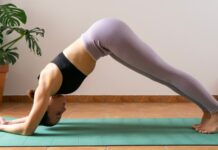Chair yoga can benefit Alzheimer’s patients by helping improve mobility, strengthening emotional connections, and promoting mindfulness.
World Alzheimer’s Day, observed annually on September 21, helps raise awareness about Alzheimer’s disease and encourages conversations about the challenges people face. Caregivers and families often find this journey emotionally challenging. When a loved one has Alzheimer’s, they may lose their memory and also have trouble with movement, balance, and focus. Caregivers may feel like their loved one is drifting away more each day. Despite these challenges, there is a simple and joyful practice that can help: chair yoga. It allows people to move, breathe, and connect with themselves, improving the lives of both Alzheimer’s patients and their caregivers.
Chair yoga for Alzheimer’s patients
Alzheimer’s disease can make it hard and unsafe to do standing or floor exercises. “Chair yoga makes it easier for people to practice by bringing the ground closer to them,” Dr Yogrishi Vishvketu, yoga educator, tells Health Shots. It uses a stable chair, gentle movements, and simple breathing techniques. Chair yoga can lead to a sense of peace of mind, drawing on traditional yoga practices, as noted by the Yoga Journal. In addition to physical benefits, it offers a unique way to find inner calm.
Chair yoga may offer several health benefits:
- Safe mobility: Patients can engage without the fear of falling, as per the American Journal of Lifestyle Medicine.
- Improved circulation: Gentle movements keep muscles and joints nourished.
- Enhanced focus: Breathing and gentle movements encourage moments of mindfulness as per News in Health.
- Emotional connection: Shared practice fosters deeper bonds between caregivers and patients.
Which yoga is best for Alzheimer’s?
Dr Yogrishi Vishvketu shares some gentle chair yoga exercises for Alzheimer’s patients. These movements not only benefit physical health but also create opportunities for connection.
-
Joint mobility flow
Why it helps: Moving your joints with simple exercises helps keep them flexible, reduces stiffness, and improves blood flow. This is especially important for people who sit for a long time.
- Neck rolls: Slowly circle the head in one direction, then switch.
- Shoulder rolls: Lift shoulders toward ears, then roll back and down.
- Wrist circles: Extend arms forward and rotate wrists in both directions.
- Ankle circles: Lift one foot and rotate the ankle, then switch sides.

2. Seated cat-cow (marjariasana)
Why it helps: This practice maintains spinal flexibility, aids in breathing, and promotes awareness of posture.
- Sit tall with feet grounded.
- Inhale while arching your back, opening the chest.
- Exhale, rounding the spine and drawing the chin in.
3. Seated twist
Why it helps: This encourages spinal mobility and stimulates digestion, as per the National Spine Health Foundation.
- Sit up straight, placing your right hand on your left knee and your left hand behind you.
- Inhale to lengthen your spine, and exhale to twist gently.
- Repeat on the other side.
4. Seated side bend (ardha chandrasana)
Why it helps: This opens the ribcage, improves lung capacity, and stretches the side body.
- Place your right hand on the seat, inhale, and lift your left arm overhead.
- Exhale, bending gently to the right; repeat on the other side.
5. Bhramari (humming bee breath)
Patients may also try Bhramari Pranayama, known as the “humming bee breath”, as per The Yoga Institute. This practice comes from Restorative Raja Yoga. “Bhramari is gentle and helps calm the nervous system while releasing stress”, shares the yoga expert.
Why it helps: It activates the body’s “rest and digest” mode, helps to balance hormones and stabilise mood, supporting deep, restful sleep, and potentially reduces inflammation, which is often linked to cognitive decline.
- Inhale gently through the nose.
- Exhale with a soft “mmm” sound, feeling the vibrations in your head and chest.
Bhramari can be practised in two ways:
- During asanas: Hum on the exhale while moving, enhancing relaxation.
- Separately: As a closing practice, guiding the mind toward stillness and meditation.
Wrap up your chair yoga session with a minute of Bhramari, allowing the soothing sound to fade into silence. Sit quietly together afterwards. This stillness can be incredibly healing.
Chair yoga tips
Here are some handy tips to ensure your chair yoga sessions are beneficial for both you and your loved one:
- Keep it short: 5–15 minutes is sufficient for effective practice.
- Establish a routine: Practising at the same time each day fosters comfort and predictability. Consider adding favourite music to enhance the atmosphere.
- Celebrate effort: Focus on effort over perfection. Every breath counts and contributes to progress.
- Join in: Practising together can deepen trust and strengthen your bond.
Will a healthy lifestyle help prevent Alzheimer’s disease?
A recent study published in The Journal of Prevention of Alzheimer’s Disease shows that Alzheimer’s patients can benefit from a well-rounded lifestyle. This lifestyle should encompass regular physical activity, an anti-inflammatory diet, mindfulness practices, and meaningful social connections. Chair yoga may be an excellent fit for this approach, as it helps improve physical health, mental clarity, and emotional well-being.





